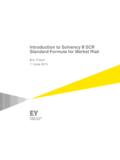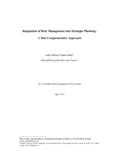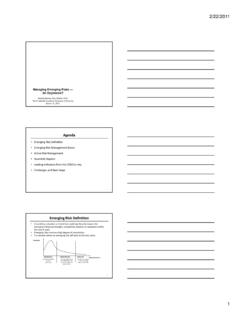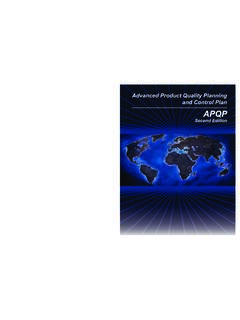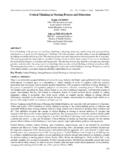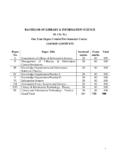Transcription of An ERM Maturity Model - Enterprise risk …
1 Paper submitted for the: Enterprise Risk Management Symposium April 22-24 2013, Chicago, IL An ERM Maturity Model Barbara Monda( ), Marco Giorgino Politecnico di Milano - Management, Economics and Industrial Engineering Department ABSTRACT In the recent years, Enterprise Risk Management (ERM) has emerged as a new risk management technique aimed to manage the portfolio of risks that faces an organization in a integrated, Enterprise -wide manner. Unlike traditional risk management, where individual risk categories are managed from a silo-based perspective, ERM involves an holistic view of risks allowing to take into account correlations across all risk classes. The academic literature on ERM is focused on two main aspects: the analysis of the factors that influence ERM adoption and its effects on firms performances.
2 No studies have been conducted yet to propose robust and rigorous models to evaluate the quality, or Maturity , of ERM programs implemented by firms. The aim of the research described in this paper is to fill this gap in the literature. In order to build a rigorous ERM Maturity Model , we have run an e-mail Delphi procedure involving a panel of worldwide experts on ERM and reached their consensus on the selection of a set of ERM best practice parameters, which are used to develop a structured questionnaire to be administered to firms. Experts consensus in obtained also on the scales and the scores for each questionnaire answer option. The output of the Delphi method is a scoring Model that can be used to assess the Maturity of an ERM program by administering a questionnaire composed of 22 closed-end questions to firms: answers are collected and scored, and all scores are combined in a single final score, the ERM Index (ERMi).
3 The robustness of the Model has finally been tested on a small sample of firms. We foresee two different uses of the ERMi Maturity Model , one by scholars for further quantitative research on ERM topics, and one by practitioners, as ERMi is suitable to be used by firms for a self-assessment of their ERM programs (internal use), and by consultancy firms, auditors and rating agencies (external use). The difference with other existing Maturity models is its solid scientific base, the rigour with which it has been designed and the fact that it is derived from a Delphi procedure involving leading ERM experts who reached consensus on the Model detailed design. Keywords: Enterprise Risk Management, Maturity Model , Delphi method ( ) Corresponding author.
4 Tel + 39 02 2399 2779; Fax + 39 02 2399 4083; E-mail: JEL codes: G32 1. INTRODUCTION Enterprise Risk Management (ERM) is an integrated way to manage risks. It differs from traditional risk management, where risks are managed separately according to their category or the company department where they arise. ERM tries to align strategic objectives given by the Board of Directors with daily operations. A peculiar characteristic is that risk is not only seen from a down-side perspective, but also as an opportunity that can be exploited for competitive advantage. In literature the name ERM is sometimes substituted by synonyms like Enterprise -Wide Risk Management, Holistic Risk Management, Integrated Risk Management and Strategic Risk Management.
5 In addition, the definition of ERM is not unique, but several definitions have been proposed by different authors end entities; for the purpose of this research project, the definition adopted is the one given by the CoSO A process, effected by an entity's board of directors, management and other personnel, applied in strategy setting and across the Enterprise , designed to identify potential events that may affect the entity, and manage risks to be within its risk appetite, to provide reasonable assurance regarding the achievement of entity objectives . The implementation of an ERM system is a big change management issue and absorbs plenty of resources both in terms of finance and human resources.
6 So why should firms embrace ERM? A number of theoretical motivations apply. According to CoSO, ERM is intended to promote awareness of the sources of risks and address them by improving strategic and operational decision-making. As a result of improved efficiency, firm performance should increase, volatility should decrease and cost of capital should be reduced, thus firm value should increase (Beasley et al. 2008). Another hypothetic benefit of ERM is the creation of synergies between different risk management activities: by integrating risks across classes and departments, firms are supposed to be able to avoid duplication of expenditures ( insurance) by exploiting natural hedges (Meulbroek, 2002).
7 Despite the theoretical motivations, if and to which extent ERM adds value is yet to be proven. In fact, there is little evidence in literature of empirical studies on the effect of ERM on firm value and most of the available studies target only financial institutions. The few studies available generally report positive correlation between ERM adoption and firm value , but all suffer from the lack of a measure of the quality of the ERM implementation, which forces the authors to consider ERM implementation as a binary variable. This paper aims to fill the gap in literature by building a rigorous and robust measure of the quality, or Maturity , of ERM implementation. In order to design such a measure, first of all a thorough literature review is performed to identify best practices and recommendations given by academics and practitioners.
8 The validity of such indicators and their relative importance is determined with the use of a Delphi procedure, that is a group technique to obtain consensus from a group of selected experts. The experts are asked to select the best indicators of Maturity of ERM implementation. In the following rounds of the Delphi procedure, the indicators are transformed into questions which make a questionnaire to be used to collect data from firms. The Delphi procedure output includes the key to assign a score to all the answers and therefore obtain a final score of the Maturity of the ERM system implemented by the surveyed firm. Finally, the robustness of the Model is verified with a pilot test run on a small scale survey of real cases.
9 The scoring Model thus built, named ERM Index (ERMi), has scientific and practical relevance and two different uses can be foreseen, one by scholars and one by practitioners, the latter probably being the most relevant. In fact, the ERMi is suitable to be used by firms for a self-assessment of their ERM programs or as a check list during the ERM first implementation phase (internal use), and by consultancy firms, auditors and rating agencies (external use). It can also be used by scholars in further research studies using econometric models both as a dependent or an independent variable to investigate the determinants of ERM adoption and its effects on firms value and performances. 2. IDENTIFICATION OF ERM BEST PRACTICES A literature review is conducted in order to identify the best practices in terms of Enterprise Risk Management to be fed as starting inputs to the Delphi procedure, which requires experts to select a number indicators of ERM Maturity from the given list or to add others of their own choice.
10 In order to identify best practices, not only academic literature, but also reports and articles written by practitioners and consultancy firms and the most common ERM standards are reviewed. Evidences from the literature can be categorized in three main areas: i) risk culture; ii) ii) organization; iii) process. Risk culture Risk culture regards values, norms and behaviours shared by all members of an organisation, which determine how they act towards the Enterprise risks (Abrahim, Henry, & Keith, 2012). The risk culture influences decisions at all levels of the organisation and therefore the possibility to reach the strategic goals, thus influencing Enterprise value (IIF, 2009). Farrel and Hoon (2009) argue that developing a risk culture is a basic necessary element to implement good ERM practices.
